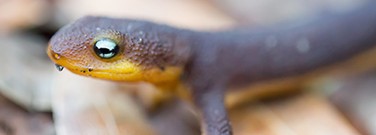Rough-Skinned Newts Are Small but Deadly
By Mike Howie
The most toxic newt in North America is only four to nine inches long. It’s known as the rough-skinned newt, and it lives in the Western United States and Canada, spread from Southwestern Alaska to San Francisco, California.
These newts have a chemical called tetrodotoxin on their skin, which can also be found in pufferfish, the blue-ringed octopus, flatworms, toads, and more. Commonly known as TTX, tetrodotoxin is a powerful paralytic that interrupts nerve signals. While a small dose may only cause tingling or numbness, larger doses can leave the newts’ predators unable to move. Some newts even have enough of the toxin to kill several humans.
Scientists were originally unsure where the TTX on these newts came from. It’s hard to produce — no other animal can make it — so it seemed unlikely that the newts would be able to. Marine animals that are known to carry TTX, for example, get it from bacteria in their tissues or from toxic prey they eat.
Patric Vaelli, then working at Michigan State University, led a team to investigate how rough-skinned newts came to have the toxin. Thinking bacteria may be the answer, they collected samples from the newts’ skin and grew colonies of the bacteria.
In these colonies they found four groups of bacteria that make TTX: Aeromonas, Pseudomonas, Shewanella, and Sphingopyxis. Other Pseudomonas bacteria were previously identified as the bacteria that produces TTX in pufferfish, sea snails, and other creatures, and the newts had more of the bacteria on their skin than do related, but non-toxic, newts.
Scientists still have more to learn about the toxin and the animals that make use of it. They don’t fully understand how bacteria produce TTX, and they’ve identified newts with forms of the toxin not seen in bacteria.
The newts, however, are not concerned with where the toxin comes from. It keeps many predators at bay, and that’s enough for them.
Discussion Questions
- What other animals are toxic?
- Why are many toxic amphibians brightly colored?
Vocabulary
- Paralytic
- Pseudomonas
- Tetrodotoxin

